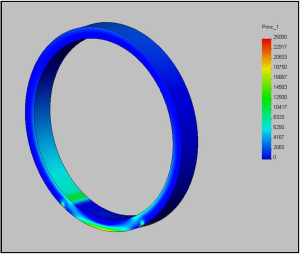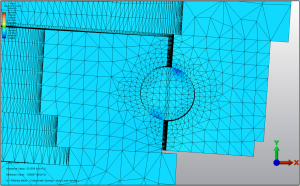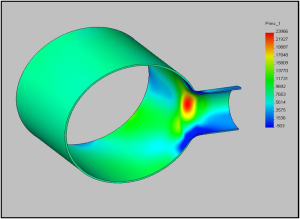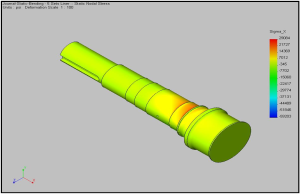
-
Evaluate Design Adequacy of New Equipment
-
Evaluate Fitness-for-Service of Existing Equipment
-
Supplement Failure Analysis to Determine Root Causes and Engineer Optimum Repair Solutions
-
Provide Quick, Practical, Cost-Effective Solutions
Acuren has used finite element analysis (FEA) to analyze pressure vessels, piping, tanks, turbines, and other industrial equipment and components. FEA is a practical method to assess and accurately evaluate equipment and process interaction.
Acuren uses advanced analysis techniques to provide quick turnaround solutions to critical industry problems, which can save clients time and money in avoided repairs, reduced business interruption, and improved reliability.
 The use of conventional tools to determine equipment fitness-for-service (FFS) often results in overly conservative assessments, which can then lead to unnecessary repairs, replacements, or non-optimum equipment operation. Acuren specializes in evaluating a wide range of pressure containing equipment and structures using advanced analytic techniques including linear and nonlinear, static and dynamic analyses. In addition to FEA, Acuren utilizes other advanced analytical tools to perform piping analysis, fitness-for-service, and numerical fracture mechanics analysis.
The use of conventional tools to determine equipment fitness-for-service (FFS) often results in overly conservative assessments, which can then lead to unnecessary repairs, replacements, or non-optimum equipment operation. Acuren specializes in evaluating a wide range of pressure containing equipment and structures using advanced analytic techniques including linear and nonlinear, static and dynamic analyses. In addition to FEA, Acuren utilizes other advanced analytical tools to perform piping analysis, fitness-for-service, and numerical fracture mechanics analysis.
FEA utilizes a computer model of a component or assembly that is usually stressed and analyzed for specific results such as deflection or stress intensity. FEA is most commonly used for new product design or product refinement. However, using FEA to determine or verify failure scenarios is equally practical.
 FEA can be done using 2-D modeling or 3-D modeling. 2-D modeling requires less computer resources and allows the analysis to be performed faster. However, interpretation of the data tends to be trickier. 3-D modeling requires significantly more computer resources; however, it produces results that are more visually meaningful. 2-D modeling or 3-D modeling can be either linear or non-linear.
FEA can be done using 2-D modeling or 3-D modeling. 2-D modeling requires less computer resources and allows the analysis to be performed faster. However, interpretation of the data tends to be trickier. 3-D modeling requires significantly more computer resources; however, it produces results that are more visually meaningful. 2-D modeling or 3-D modeling can be either linear or non-linear.
Linear systems are far less complex and generally do not take into account plastic deformation. Non-linear systems do account for plastic deformation, and are capable of testing a material all the way to fracture.
 FEA uses a complex system of points called nodes which make a grid called a mesh. The mesh is programmed to contain the material properties that define the stiffness of the structure under loading conditions. Nodes are assigned at a certain density throughout the material depending on the anticipated stress levels of a particular area. Regions of higher stress usually are given a higher node density (tighter grid) than those regions of little or no stress.
FEA uses a complex system of points called nodes which make a grid called a mesh. The mesh is programmed to contain the material properties that define the stiffness of the structure under loading conditions. Nodes are assigned at a certain density throughout the material depending on the anticipated stress levels of a particular area. Regions of higher stress usually are given a higher node density (tighter grid) than those regions of little or no stress.
There are multiple loading conditions that may be applied to a FEA model. These include point load, pressure, gravity, centrifugal loads, forced displacements, thermal loads, heat flux, and convection, all of which can either be static (constant) or dynamic (variable).
For a Print Friendly brochure, click the link below.
Finite Element Analysis & Computational Mechanics

